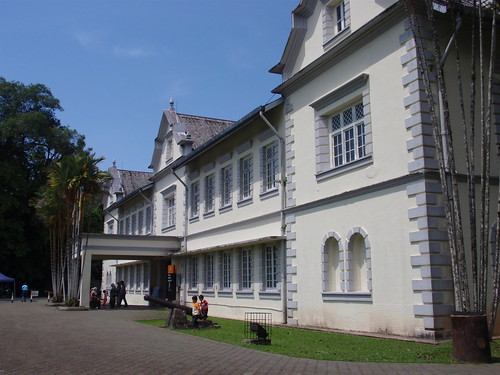
I love the story of the design of this building. It's a copy of a Normandy Town Hall, designed by the valet of the second 'white rajah', Charles Brooke. It's a very old-fashioned museum whose ground floor is full of beautifully constructed cases with rocks, minerals, shells, and rather scruffy aged samples of the amazing animals and birds to be found in Sarawak. Upstairs, in a rather elegant space, is the collection of ethnographically rich material culture from the peoples of Sarawak that the museum is most noted for.
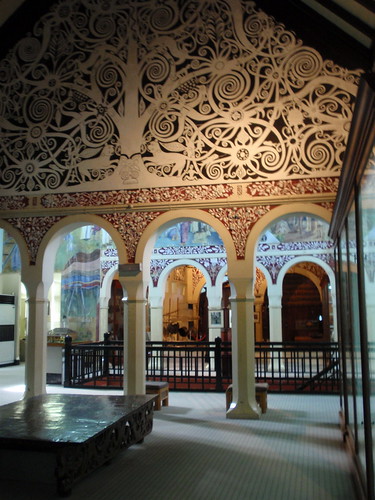
It's the kind of museum that tempts anybody who has ever had the slightest temptation to collect anything...'wouldn't it be wonderful to have a set of old Chinese dishes?', 'I wonder if I could buy baskets like those...' But ultimately, I found it somewhat unsatisfying. However beautiful or unusual or representative the exhibits are, I want to know more of their context. I want to know how they were used and by whom, and whether the decorative quality of the object has a meaning. Nowadays, the Sarawak Museum is a rather lovely historical example of an ethnographic museum.
Maybe others had also felt the need for context for in 1990 the Sarawak Development Corporation constructed the Sarawak Cultural Village outside Kuching in a superb natural forest. I think most of us are very wary of the cliched 'recreations' of ways of life, but I think this one works surprisingly well. There are traditional buildings - including longhouses - built by and for each tribal group, and handicrafts such as weaving or carving are practised by people living or staying for some time in the houses.
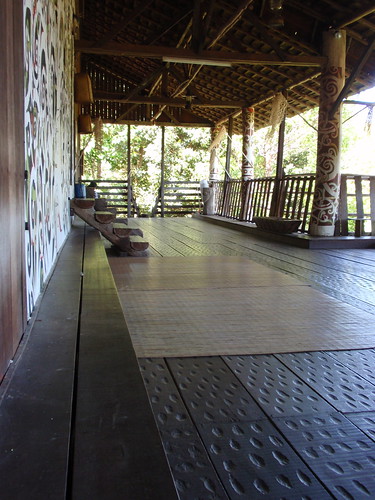
Orang Ulu Longhouse verandah
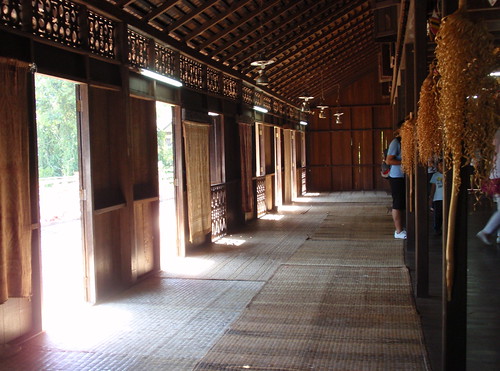
Iban Longhouse
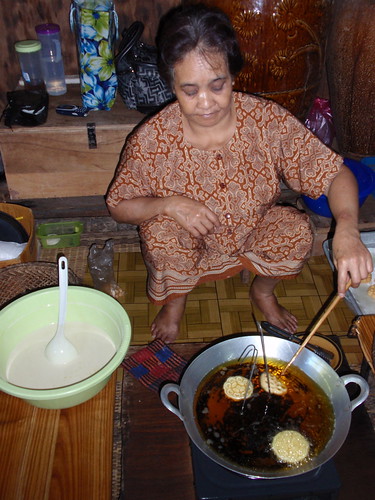
Iban woman frying rose pastries
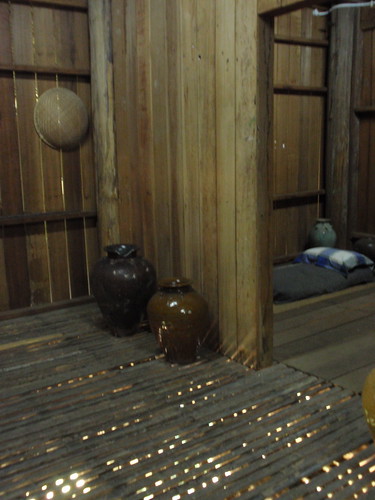
Melanau Tall House interior
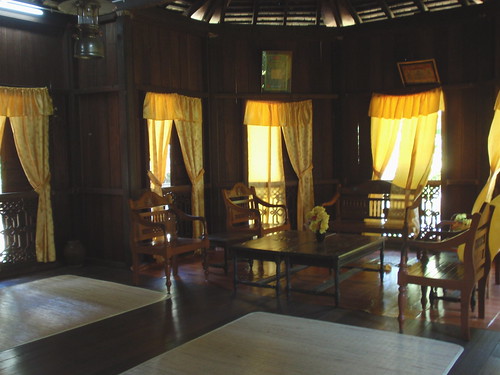
Malay House
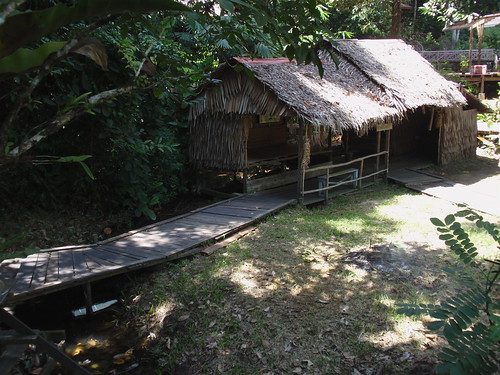
Penan House
The Cultural Village clearly has a political purpose. It was filled with people the day we visited. There were a few Western tourists, but most of the visitors were local people - some from the area, some of them internal tourists from peninsular Malaysia, and groups of high school and college students. The Village provides some public validation for the tribal groups in Sarawak and their customs and way of life, within a community where they are otherwise the most disadvantaged. There is also a public presentation of Malaysia as unified within its diversity - which is an aspiration for how the society could work but sometimes falls short.
We enjoyed our visit to the Sarawak Cultural Village and the opportunity it gave us to see something of the architecture and artifacts of the traditional peoples of the Sarawak area. We also loved seeing the responses of others to these displays. But I guess the uncomfortable thing is that this is after all a display, and to find the right line between objectifying the groups of people whose cultures are displayed and accepting those customs as a natural part of the wider culture is very delicate and difficult.
There were no such dilemmas when we visited the Australian War Memorial at Sandakan in Sabah in North Borneo. This is a park with a simple pavilion with well-designed, simple, text, photos and illustrations telling the story of the Sandakan POW camp and the death marches to Ranau during the second world war. The exhibition in the pavilion has been put together by the Australian War Memorial and is impressive in its simplicity and understatement. It's a story that doesn't need exaggeration or embellishment because it is so shocking. In 1942 and 1943 the Japanese brought about 2,700 prisoners of war to the Sandakan camp to work as labourers to build an airfield. The climate, disease, infection, starvation and harsh treatment took their toll. Towards the end of the war the Japanese retreated from Sandakan and forced the POW's to act as carriers for the trek through the jungle. By the end of the war, all except six of the 2,700 POWs were dead. These six Australians had escaped during the march or after reaching Ranau and it is their stories that reveal the full horror or the Sandakan camp and the marches.

The memorial works because it's simple, and tells much of its story in the six survivors' own words and because, as well as remembering the POWs, it acknowledges the assistance given by the local people and their suffering and resistance during the Japanese occupation.
Another simple, but much quirkier museum we've visited in Sandakan is Agnes Keith's House.
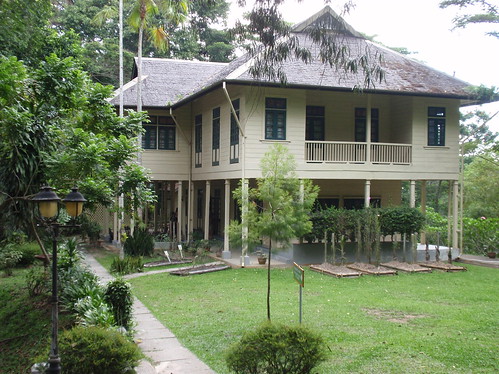
Agnes Keith was a writer who lived in Sandakan with her English husband from 1934 to 1952 - initially living the life of an expatriate wife in a rather backwater colonial outpost. She wrote about these experiences but became much better known after the publication of her book 'Three Came Home', based on her own and her family's experiences when interned for three years by the Japanese during the second world war. The Keith's wooden house was built on a hill overlooking the town, but was destroyed during the war. A replica of the original house was rebuilt by the government after the war and Henry Keith and his wife came back to Sandakan.
The house is decorated with furniture of the 30s and 40s and with photos of the Keiths and their work and social lives. I'm not sure why this museum works so well. I guess it's because it evokes a way of life that no longer exists and that seems almost inconceivable when contrasted with today's Sandakan. It very successfully creates the context of Agnes and Harry Keith's lives.
I'm sure there'll be more museums before our trip is finished.
3 comments:
I wonder if the Keith house works so well because of the contrast it provides to the Sandakan Cultural centre? Very different ways of life, I suppose?
War memorials always make me blubber almost uncontrollably - the horrors that were inflicted and endured just affect me so much. It's so important to remember these things.
Thank you again for an interesting take on Malaysia - I would not have thought of any of those things in relation to the word so you have definitely broadened my knowledge base.
I too love to ponder my way through museums and often get caught up reading every bit of information available, in the end lingering far longer than expected. I guess this is the joys of holidays, time is on your side and you can relax and spend the time to do so.
I love the the floors of the long house - so beautiful.
Sounds like your both having a wonderful time, I'm enjoying reading about your trip :D
Post a Comment